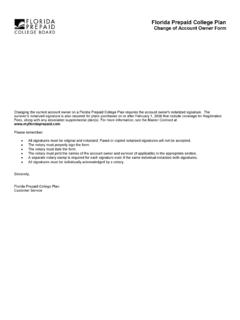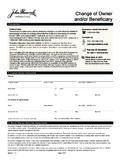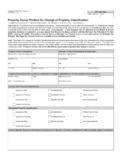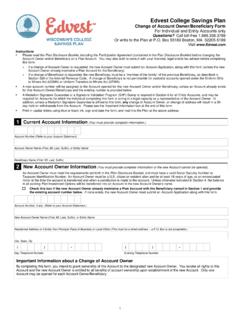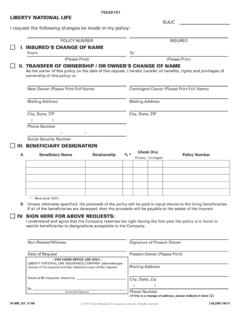Transcription of Date: October 26, 2016 Mortgagee Letter 2016-15 To
1 DEPARTMENT OF HOUSING AND URBAN DEVELOPMENT WASHINGTON, DC 20410-8000 ASSISTANT SECRETARY FOR HOUSING- FEDERAL HOUSING COMMISSIONER Date: October 26, 2016 Mortgagee Letter 2016-15 To: All FHA-Approved Mortgagees All Direct Endorsement Underwriters All FHA Roster Appraisers All HUD-Approved Housing Counselors All HUD-Approved Nonprofit Organizations Subject Federal Housing Administration (FHA) Condominium Project Approval owner Occupancy Requirement Background In accordance with the passage of the Housing Opportunity Through Modernization Act of 2016 (HOTMA), the Federal Housing Administration (FHA) is required to provide guidance on the percentage of owner occupied units required to obtain condominium project approval.
2 owner occupied units are defined as principal residences, secondary residences, currently occupied units by the owners, or units that have been sold to purchasers who intend to occupy them as a primary or secondary residences. FHA has historically set standards for condominium project approval where units have a high probability for success and has required owner occupancy as a component of condominium project approval. Prior to implementation of the Housing and Economic Recovery Act (HERA) of 2008, the required owner occupancy percentage was as high as 80 percent, but was lowered to 51 percent. After HERA, FHA adjusted the owner occupancy percentage to its current level of 50 percent for existing projects and 30 percent for Proposed, Under Construction (including existing projects less than 12 months old) or Gut Rehab Conversions.
3 It is FHA s position that owner occupants serve to stabilize the financial viability of the projects and are less likely to default on their obligations to ownership associations than non- owner occupants. If a unit owner defaults on his or her obligations to the ownership association, the entire project is subject to an increase in risk including, by extension, FHA mortgagors. owner occupants, unlike either investors or renters, are incentivized to cooperate with other unit owners to ensure successful operation of the project. Analysis of FHA s insured condominium portfolio over the past few years indicates that condominium loans have a lower default rate than other FHA 2 programs, which FHA attributes, in part, to its project-wide owner occupancy requirements.
4 FHA takes seriously its responsibility to take a balanced approach in providing affordable, sustainable housing opportunities while maintaining its fiduciary responsibility to properly manage and mitigate risk to the Mutual Mortgage Insurance Fund (MMIF). FHA has determined that for most projects, the existing owner occupancy requirements are necessary to maintain the stability of the Mutual Mortgage Insurance Fund; however, in certain instances, HUD believes that it would be possible to protect the fund while allowing a lower owner occupancy percentage if certain adjustments are made to enhance other requirements that affect the financial stability of the project. HUD s experience shows that higher reserves, a low percentage of association dues in arrears, and evidence of long-term financial stability (as evidenced by financial documents) enable a lower occupancy percentage without unduly increasing risk to the MMIF.
5 Therefore, HUD may approve an occupancy percentage as low as 35 percent if the requirements stated in this Mortgagee Letter are met. Purpose The purpose of this Mortgagee Letter (ML) is to modify the Condominium Project Approval and Processing Guide, attachment to ML 2011-18 (as modified or extended by MLs 2012-18, 2014-17, 2015-27 and 2016-13) in order to implement the HOTMA requirements and establish the required occupancy percentage that must be met for purposes of FHA project approval. Further, this ML establishes requirements for conditions under which an individual condominium project could be approved at a lower percentage. The policies referenced above are superseded to the extent they conflict with the policies in this ML.
6 Effective Date This Mortgagee Letter is effective immediately for all condominium project approval applications, recertification applications, annexation applications or reconsideration applications submitted for review. _____ Condominium Project Approval and Processing Guide Section Section of the Condominium Project Approval and Processing Guide is amended as follows: A. Definition of owner Occupancy: owner occupied units are defined as principal residences, secondary residences, or units that have been sold to purchasers who intend to occupy them as a primary or secondary residence. A principal residence refers to a dwelling where the owner maintains or will maintain their permanent place of abode, and which the owner typically occupies or will occupy for the majority of the calendar year.
7 A secondary residence refers to a dwelling that an 3 owner occupies in addition to their principal residence, but less than a majority of the calendar year. A secondary residence does not include a vacation home. B. owner Occupancy Percentages: Project Status Requirement Existing (projects fully completed and over one-year-old or non-gut rehab conversions) At least 50 percent of the units of a project must be owner -occupied or sold to owners who intend to occupy the units. The owner occupancy requirement may be lowered to as low as 35 percent if the project meets the conditions outlined below in section C. Proposed, Under Construction (including existing projects less than 12 months old) or Gut Rehab Conversions FHA will allow a minimum owner -occupancy percentage of 30 percent of the declared units.
8 Legally phased projects must meet 30 percent presale and 30 percent owner occupancy requirements. (See chart referred to in Pre-Sale Requirements, section 3-4). C. Conditions to Lower owner Occupancy Percentage for Existing to as low as 35 percent Existing projects (greater than 12 months old) with an owner occupancy percentage of at least 35 percent and less than 50 percent are eligible for approval under the following circumstances and subject to the following conditions: Applications must be submitted for processing and review under the HUD Review and Approval Process (HRAP) option. Financial documents (see Section ) must provide for funding of replacement reserves for capital expenditures and deferred maintenance in an account representing at least 20 percent of the budget; and No more than 10 percent of the total units can be in arrears (more than 60 days past due) on their condominium association fee payments (as defined in Section of the Guide; and Three years of acceptable financial documents (see Section ) must be provided.)
9 4 Documentation: The owner -occupancy percentage must be documented as follows: Copies of sales agreements and evidence (loan commitment) that a Mortgagee is willing to make the loan; or Evidence that units have closed and are occupied by the owner ; or Information from a developer/builder that lists all of the units already sold, under contract, or closed that are or will be occupied by the owner ( a spreadsheet, chart, or listing used for the company s own tracking purposes) that is accompanied by a signed certification from the developer. Information Collection Requirements The information collection requirements contained in this document have been approved by the Office of Management and Budget (OMB) under the Paperwork Reduction Act of 1995 (44 3501-3520) and assigned an OMB control number of 2502-0610.
10 In accordance with the Paperwork Reduction Act, HUD may not conduct or sponsor, and a person is not required to respond to, a collection of information unless the collection displays a currently valid OMB control number. Questions Any questions regarding this Mortgagee Letter may be directed to the FHA Resource Center at 1-800-CALL FHA (1-800-225-5342). Persons with hearing or speech impairments may reach this number by calling the Federal Relay Service at (800) 877-8339. For additional information on this Mortgagee Letter , please visit Signature Edward L. Golding Principal Deputy Assistant Secretary for Housing











